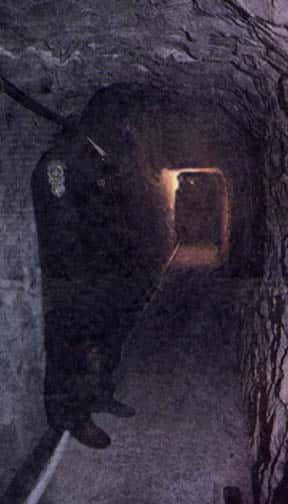Border Tunnels Part 2
The problem with wandering about looking for something important like a tunnel is that you really do not know what it should look like when you find it because you have not seen it in exactly the spot you are now looking.
Yes, if you do not know what it should look like then you don’t know what you are looking for. This is not an important issue to Washington, D.C.
There may be all sorts of things
beneath the ground that affect your detector and that have been there all along and you did not know it because you never looked here before.
The best way to find a tunnel is to make a history of the area and then compare that history with what you found this time.
Why do we explore tunnel finding methods before we describe tunnels? Because if the smugglers think they know what methods we might use to find their tunnel then they will build their tunnel to evade such detection methods.
Some tunnels can be 3,000 feet long, three feet wide and seven feet high with concrete floors, railroad rails, electric lights, water pumps, and Port a-Potties half way along the tunnel. Such tunnels will be very deep indeed.
The last tunnel discovered of this type was about 80 feet below ground.

This kind of investment is reserved for places like the San Diego / Tijuana area. This tunnel cannot be detected by the government’s fashionable
detection methods in use today.
These fashionable methods include Ground Penetrating
Radar (GPR). GPR usually does not penetrate deeper than about 40 feet. GPR is used in the San Diego area.
People with interest in such things, south of the border, watch ICE people north of the border using GPR equipment in the No Man’s Land
between the primary and secondary fences. They have binoculars and video cameras and radios and think a bit.
This tunnel was, therefore, put 80 feet below ground.
Most tunnels are far smaller and shallower. In Calexico the tunnels can be two feet in diameter, 70 feet long and often only five feet below ground. In Calexico they do have the problem of a shallow water table and so tunnels deeper than about 18 feet can pose a serious problem to the builders.
One method of making such tunnels invisible to DHS people is to put the tunnel at an angle. Going directly across the border due north will look like you have a tunnel going directly due north. If you instead dig your tunnel at an angle — a 45 to 70 degree angle — then this cannot be a tunnel because it is not going due north.
The best way — according to DHS in their instructions to border people — to find tunnels is to drive your vehicle over the ground and when your wheel falls in a hole, you have discovered a tunnel (really).
Sometimes, mistakes are made and the digger becomes a permanent part of his work.
The last method of tunneling
is to take advantage of existing infrastructure. All along the border smugglers will dig very shallow tunnels — sometimes more like caves — that intercept some existing storm drain along the U.S. side of the border. Once into the storm drain the smuggler can crawl in concrete lined luxury to the nearest curbside manhole cover and exit. This can be very bad if you have a group of ten and one of the ten — maybe the third one trying to exit — has wide hips. Suddenly you have this Giant Odd Wriggling Event at curbside and Americans arrive in red trucks with ladders and helmets and then they call in special red painted rescue trucks and after hours of jack hammering, you are all summarily deported.
If the tunnel is to be used for some extended period of time then the smuggler will not do anything to the U.S. side of the drain system that might give them away. For example, there was one tunnel that accessed a storm drain on the U.S. side and the smuggler would crawl through the drain and simply hand huge packets of drugs up to his accomplice in a van parked in a parking lot not 50 feet from U.S. federal officers. How did they hide this from the officers? They cut a hole in the floor of the van and then dropped a blanket through the hole in the floor of the van and passed all the drugs through this drapery tube.
Others are quicker thinkers and just use the existing storm drain system required by treaty that allows free flow of fluids
between the USA and Mexico. These people will bring cutting torches and battery powered saws and just walk north up the pipe and then burn and hack away at the steel grates on the north end of the storm drain.
Stopping this quite successful method requires the use — by DHS — of steel tubing six inches in diameter that is filled with concrete. This works because standard saws can’t cut stuff six inches in diameter and torches can’t burn through it because they can’t access the far side in the time they have before several groups of people peer down at them with red lights flashing and the smell of gun leather in their nostrils. What kind of grate is used today? Well, not that.
